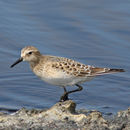fr
noms dans le fil d’Ariane


Although this small (7-7 ½ inches) shorebird undertakes a remarkable long-distance migration each year, Baird’s Sandpiper is somewhat less remarkable in terms of physical appearance. Dull gray-brown above with a medium-length bill, black legs, and faint eye-stripe, Baird’s Sandpiper is easily confused with many similar-looking species of sandpiper that occur in its range and on migration. With the help of a high-powered field scope, this species may be identified by its long wings and lack of a white rump patch. In winter, this species’ plumage becomes less distinct, adding another layer of confusion to its identification. Male and female Baird’s Sandpipers are similar at all seasons. Baird’s Sandpiper breeds primarily in northern Alaska and on islands in arctic Canada. This species undertakes a fast-paced migration in which it traverses the entire continent of North America in the space of a few weeks. Baird’s Sandpiper winters in central and southern South America. In the breeding season, Baird’s Sandpiper inhabits relatively dry stretches of tundra. On migration, this species may be found for short periods of time in various kinds of freshwater wetlands. During the winter, this species inhabits damp fields and grasslands. Insects make up a large portion of the diet of Baird’s Sandpiper, which picks them off the ground, but small crustaceans may also be consumed. Due to its remote breeding habitat, most birdwatchers never see Baird’s Sandpiper during the summer. Similarly, many North American birdwatchers never travel far enough south to see this species during the winter. Most sightings in temperate regions of North America take place during the spring and fall, when this species may be seen in small numbers near water. Baird’s Sandpiper is primarily active during the day.
Calidris bairdii
Le Bécasseau de Baird (Calidris bairdii) est une espèce d'assez petits oiseaux limicoles de la famille des Scolopacidae.
Le Bécasseau de Baird niche dans l’extrême est de la Sibérie, en Alaska, dans le nord du Canada et du Groenland. Il est accidentel en Afrique et en Europe occidentale.
Calidris bairdii
Le Bécasseau de Baird (Calidris bairdii) est une espèce d'assez petits oiseaux limicoles de la famille des Scolopacidae.